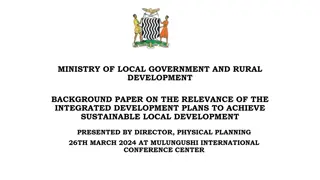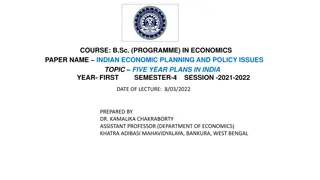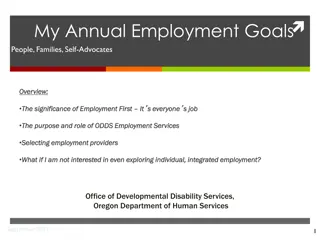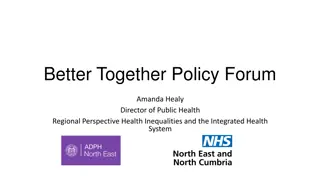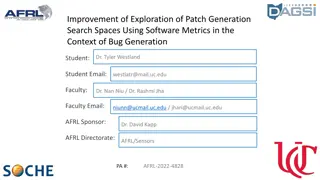Strategic Integrated Evidence Generation Planning Tips
This resource provides key tips and resources for Medical Affairs teams to develop integrated evidence generation plans, emphasizing the value of strategic planning. Tailor recommendations to suit your organization, product, and treatment landscape. Understand the importance of evidence for various stakeholders and how it can impact decision-making.
Download Presentation

Please find below an Image/Link to download the presentation.
The content on the website is provided AS IS for your information and personal use only. It may not be sold, licensed, or shared on other websites without obtaining consent from the author. Download presentation by click this link. If you encounter any issues during the download, it is possible that the publisher has removed the file from their server.
E N D
Presentation Transcript
Strategic Integrated Evidence Generation Planning Tips and Templates Medical Affairs Professional Society | 2023 < > 1
Acknowledgements The Medical Affairs Professional Society (MAPS) would like to thank the following contributors to Strategic Integrated Evidence Generation Planning Guidance Document: Phil Wakefield, Chief Advisory Services Officer, Inizio Medical Rachel Hatfield, Managing Partner, MEDiSTRAVA Consulting Ann Hartry, AVP, Value, Evidence & Outcomes, Eli Lilly and Company Damian Largier, Global Medical Affairs Lead, Migraine, Pfizer Esther Liu, Senior Director, Integrated Evidence Generation, Eli Lilly and Company Bhavik Pandya, Global Director HEOR Oncology, Medical Affairs, Astellas Cerise James, Principal, Medical Affairs, Tilghman James Group LLC And with appreciation for the ongoing support from the Evidence Generation FAWG Those named above contributed to Strategic Integrated Evidence Generation Planning Guidance Document in their personal capacity. The views expressed and guidance provided in this document and associated presentation are their own and do not necessarily represent the views of their named employers. Medical Affairs Professional Society | 2023 < > 2
Rationale and purpose This resource is intended to provide Medical Affairs teams with key tips and resources to support integrated evidence generation plan development, as well as reinforce the potential value planning can bring The recommendations provided should be tailored to the individual organization, product, and treatment landscape The views and information provided do not reflect the position or views of any one individual or company Medical Affairs Professional Society | 2023 Medical Affairs Professional Society | 2023 < > 3
Integrated Evidence Planning: Key principles
The importance of evidence to multiple stakeholders Generation of meaningful evidence is a critical requirement from all stakeholders Patients Policymakers Better understanding of patient s unmet need can help with policy decision-making Understanding how treatments can impact quality of life as part of shared decision-making Industry Strategic evidence planning needed to support differentiated value propositions throughout the product lifecycle Payers Varying regional and local requirements need to be considered in order to support successful reimbursement and access Regulators The rise of the expedited approval process, fast track and priority reviews is requiring further consideration of evidence beyond RCT HCPs Increasing variety of treatment options is furthering the need for evidence to support treatment decision-making in order to optimize patient outcomes. Medical Affairs Professional Society | 2023 < > 5
Medical affairs is central to strategic evidence generation Identification of need, generation and communication of evidence is often disjointed with siloed departments creating and pursuing their own evidence plans Cross-functional evidence requirements are often similar, with common gaps and questions that need to be addressed through evidence generation; however, evidence plans frequently remain uncoordinated between departments Medical Affairs is ideally positioned to be the champion of coordinated, holistic evidence generation planning Medical Affairs Professional Society | 2023 Medical Affairs Professional Society | 2023 < > 6
What is an Integrated Evidence Plan? The IEP tracks evidence gaps and associated evidence generation plans including data sources, endpoints and timings together with plans for evidence dissemination. Critically, the IEP creates a commonality of approach across the various cross-functional departments of an organization The IEP provides a comprehensive view of all relevant evidence and external research that supports common evidence objectives and/or drives strategic decision making supporting the development, launch, and continued support of an asset The IEP is an internal document that prioritizes evidence generation requirements in an efficient manner across functions, countries and the product lifecycle. It is also a living document that will be regularly updated in response to external market forces and internal demands Medical Affairs Professional Society | 2023 < > 7
Example cross-functional evidence generation activities Term Definition Evidence generation activities Preclinical data Translational data and signal studies Registration trials Company-sponsored life-cycle management trials Post-hoc analyses and mining of trial data Inform strategy for investigator-sponsored studies Treatment pathways, outcomes, and resource data Clinical and economic burden Line of therapy analyses Meta-analyses Appropriate use in real life conditions Indirect treatment comparisons HEOR studies Registry mining Augment and update publications plan Develop stakeholder communication narratives Evidence generation1 Evidence generation is multidimensional, including data source, study design, and degree of pragmatism Real-world data2 Data relating to patient health status and/or the delivery of health care routinely collected including: Electronic health records; claims and billing activities Product and disease registries Patient-generated data Data gathered from other sources that can inform on health status, such as mobile devices Can form IEP Real-world evidence2 Clinical evidence regarding the use and potential benefits/risks of a product derived from RWD analysis Typically generated from observational research but can also derive from other study designs such as RCT, pragmatic trials, or large simple trials RCT, randomized clinical trials. 1. Jarow JP, et al. JAMA. 2017;318(8):703-704; 2. https://www.fda.gov/science-research/science-and-research-special-topics/real-world-evidence. Medical Affairs Professional Society | 2023 < > 8
Why is an IEP beneficial Tracks all existing and planned evidence generation and allows identification of commonalities across multiple functions to ensure both an efficient and effective means of generating evidence to strategically meet internal/external stakeholder needs Efficient Evidence Generation By following a formalized approach to its construction, the IEP provides a consistent framework across all functions Uniform Approach Transparency Increases visibility and transparency for cross-functional evidence generation needs and plans Allows for prioritization of evidence generation needs and supports decision-making with regard to resource allocation enabling elimination of redundant and low impact research ensures all gaps are identified and prioritized Prioritization of Evidence Generation Ultimately the IEP can help support the product positioning in order to best ensure realization of the brand vision Product Positioning Medical Affairs Professional Society | 2023 < > 9
Key principles for activating an IEP Geographical representation Collaborative Strategic Insight-led Living document Although medical affairs will drive its creation, cross- functional representation (e.g., clinical development, market access, commercial) is essential to maximize value Evidence needs and plans should be aligned with the priorities of the product/franchise strategy Be based on a deep understanding of key stakeholder evidence needs Global, regional and local needs should be reflected, where possible The plan should be regularly revisited to ensure it remains relevant External events, e.g. competitor data release should also prompt review Impact of activities should be tracked to determine if an alternative approach is required Medical Affairs Professional Society | 2023 < > 10
When to initiate the IEP Prior to strategic business planning each year Ideally during Proof Of Concept at Phase I/II where key insights can help shape the development of subsequent studies Some companies are producing IEPs as early as asset discovery/ pre-clinical Medical Affairs Professional Society | 2023 Medical Affairs Professional Society | 2023 < > 11
How to approach planning for an IEP Set up a cross-functional evidence generation core team Collate and review relevant documents from all internal stakeholders including: Product strategy, including vision and strategic imperatives and a TPP Landscape analyses Scientific platform and publications plan Any current patient journey, gap analyses or evidence generation plans Competitor intelligence Run internal/external stakeholder interviews to understand challenges/opportunities and allow open discussion around key research questions Medical Affairs Professional Society | 2023 < > 12
Integrated Evidence Planning: Processes and templates
Process Overview 3 4 5 1 2 PREPARE DEFINE DESIGN EXECUTE REVIEW Prepare strategic priorities for evidence needs Identify and prioritize evidence gaps Design evidence generation programs to support identified gaps Evidence generation & dissemination Ensure regular check-ins to ratify IEP Medical Affairs Professional Society | 2023 < > 14
Process Flow Prepare Define Design Execute Review Step 1: Prepare Medical Affairs Prepare strategic priorities for evidence needs Clinical Development Commercial a. Set up cross-functional IEP core team led by Medical Affairs b. Collate relevant stimuli c. Conduct internal/ external interviews d. Align on strategic priorities for evidence generation HEOR / Market Access Regulatory Medical Affairs Professional Society | 2023 < > 15
Process Flow Prepare Define Design Execute Review Step 2: Define Identify and prioritize evidence gaps Workshop 1: Interactive, cross-functional discussions, centered on aligning evidence gaps with stakeholder priorities and impact on patient outcomes Medical Affairs Professional Society | 2023 < > 16
Workshop 1: Sample template for completion Prepare Define Design Execute Review Strategic imperative Evidence gap Risk if not filled Target stakeholder Priority (H, M, L)* Geographical scope (region/country-based) *prioritization exercise on following slide Medical Affairs Professional Society | 2023 < > 17
Workshop 1: Gap prioritization Prepare Define Design Execute Review High Plan Act Grid can be used by working groups as a template to organize gaps IMPACT Hold Prioritize Low High FEASIBILITY* *resource, time, budget, risk to be considered Medical Affairs Professional Society | 2023 < > 18
Process Flow Prepare Define Design Execute Review Step 3: Design Design evidence generation plan to support identified gaps Workshop 2: gap fill exercise for priority gaps high level planning (including topline budget/ resource needs) Ratification with key internal/ external stakeholders to prioritize evidence needs Ensure gaps are not being filled as part of any current functional plans Align with appropriate functions for evidence generation activities; investigator-initiated studies, internal study design etc. Complete the IEP template to track progress and ensure all gaps are prioritized/filled as required Medical Affairs Professional Society | 2023 < > 19
Workshop 2: Sample template Prepare Define Design Execute Review GAP: Key Objective Rationale Methods Study population Comparators Primary endpoint Secondary endpoint(s) Functional owner Key timings Priority (H, M, L) Study region/country Applicability Region 1 Region 2 Region 3 Region 4 Country 1 Country 2 Country 3 Country 4 Country 5 External stakeholders SCIENTIFIC STATEMENT / AREA STUDY SUPPORTS: Medical Affairs Professional Society | 2023 < > 20
IEP Sample Template Prepare Define Design Execute Review IEGP Strategic imperative / Strategic link Gap description Anticipated data use Impact of gap not being closed Target stake- holder Priority Regional applicability (insert countries as needed) Key objective / Study description Key timings (data availability etc.) Owner (function) Budget US EU APAC Medical Affairs Professional Society | 2023 < > 21
Process Flow Prepare Define Design Execute Review Step 5: Execute Evidence generation & dissemination Share plan with functions & affiliates for execution Expand to communication planning Medical Affairs Professional Society | 2023 Medical Affairs Professional Society | 2023 < > 22
Process Flow Prepare Define Design Execute Review Step 6: Review Ensure regular check-ins to ratify IEP Set the cycle for regular review and update by IEP core team (e.g., every 6 months unless key external event) Medical Affairs Professional Society | 2023 Medical Affairs Professional Society | 2023 < > 23



















